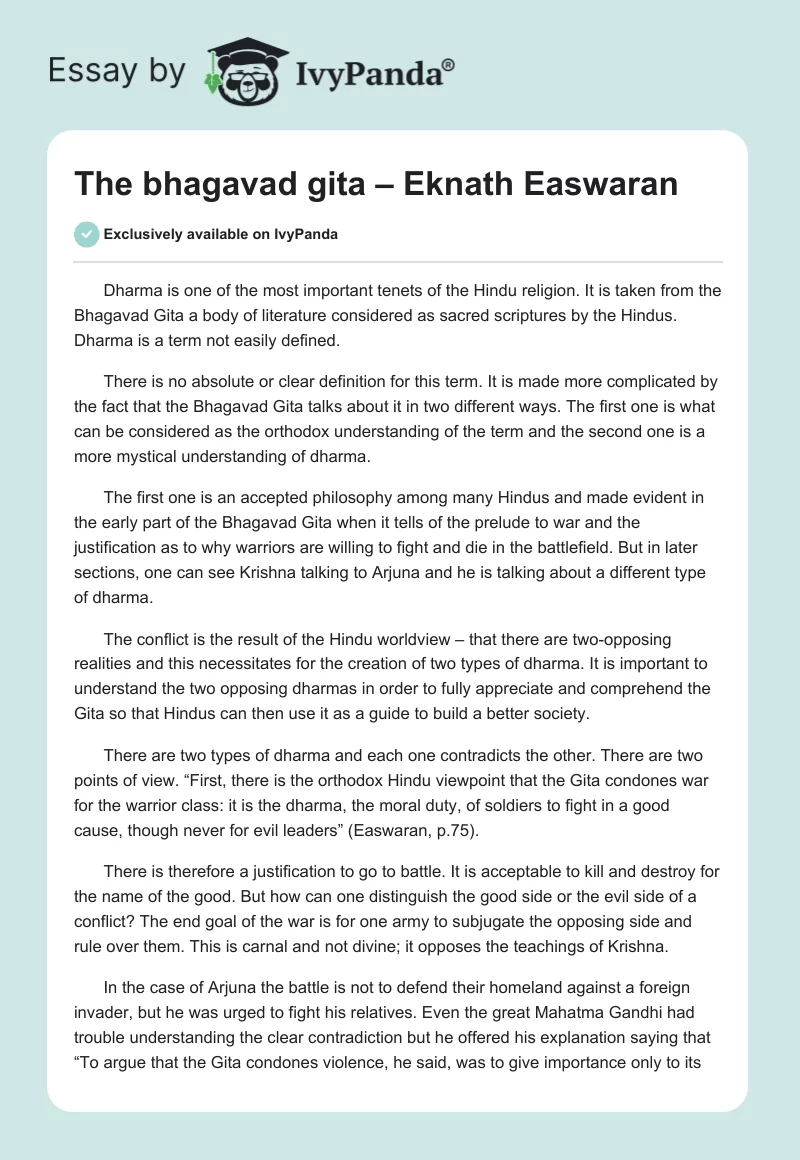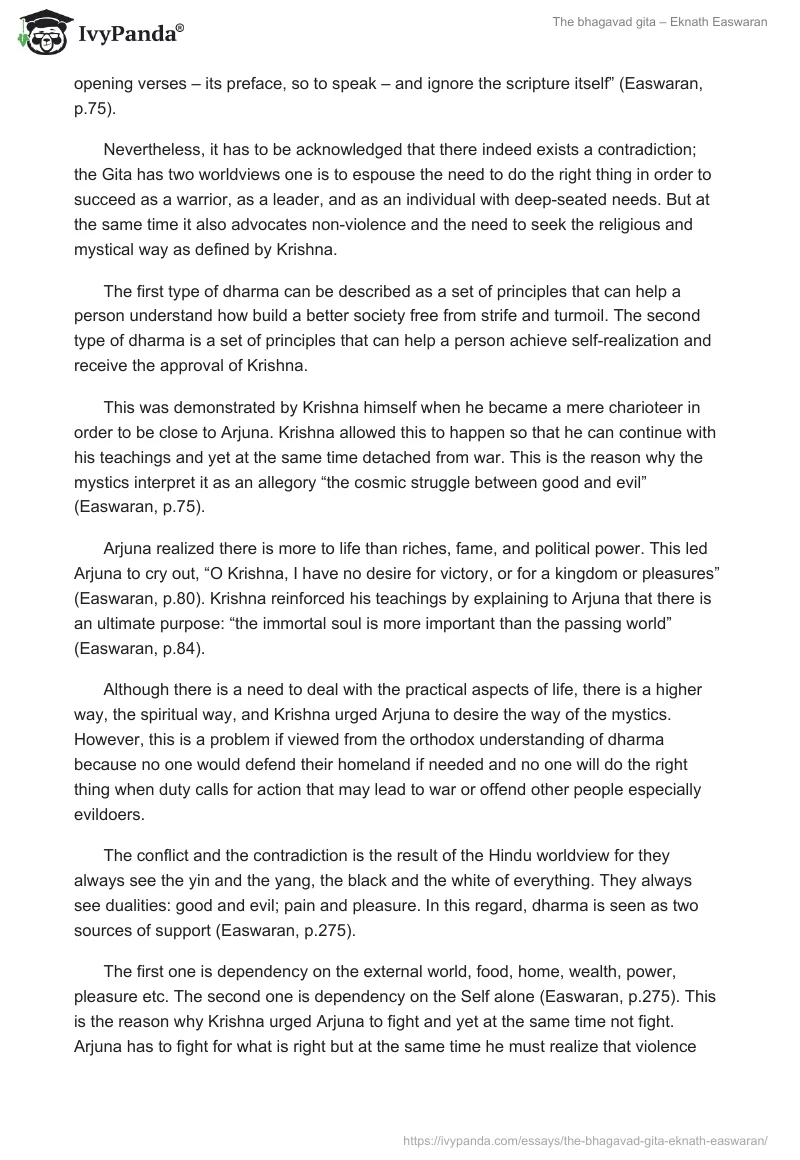Dharma is one of the most important tenets of the Hindu religion. It is taken from the Bhagavad Gita a body of literature considered as sacred scriptures by the Hindus. Dharma is a term not easily defined.
There is no absolute or clear definition for this term. It is made more complicated by the fact that the Bhagavad Gita talks about it in two different ways. The first one is what can be considered as the orthodox understanding of the term and the second one is a more mystical understanding of dharma.
The first one is an accepted philosophy among many Hindus and made evident in the early part of the Bhagavad Gita when it tells of the prelude to war and the justification as to why warriors are willing to fight and die in the battlefield. But in later sections, one can see Krishna talking to Arjuna and he is talking about a different type of dharma.
The conflict is the result of the Hindu worldview – that there are two-opposing realities and this necessitates for the creation of two types of dharma. It is important to understand the two opposing dharmas in order to fully appreciate and comprehend the Gita so that Hindus can then use it as a guide to build a better society.
There are two types of dharma and each one contradicts the other. There are two points of view. “First, there is the orthodox Hindu viewpoint that the Gita condones war for the warrior class: it is the dharma, the moral duty, of soldiers to fight in a good cause, though never for evil leaders” (Easwaran, p.75).
There is therefore a justification to go to battle. It is acceptable to kill and destroy for the name of the good. But how can one distinguish the good side or the evil side of a conflict? The end goal of the war is for one army to subjugate the opposing side and rule over them. This is carnal and not divine; it opposes the teachings of Krishna.
In the case of Arjuna the battle is not to defend their homeland against a foreign invader, but he was urged to fight his relatives. Even the great Mahatma Gandhi had trouble understanding the clear contradiction but he offered his explanation saying that “To argue that the Gita condones violence, he said, was to give importance only to its opening verses – its preface, so to speak – and ignore the scripture itself” (Easwaran, p.75).
Nevertheless, it has to be acknowledged that there indeed exists a contradiction; the Gita has two worldviews one is to espouse the need to do the right thing in order to succeed as a warrior, as a leader, and as an individual with deep-seated needs. But at the same time it also advocates non-violence and the need to seek the religious and mystical way as defined by Krishna.
The first type of dharma can be described as a set of principles that can help a person understand how build a better society free from strife and turmoil. The second type of dharma is a set of principles that can help a person achieve self-realization and receive the approval of Krishna.
This was demonstrated by Krishna himself when he became a mere charioteer in order to be close to Arjuna. Krishna allowed this to happen so that he can continue with his teachings and yet at the same time detached from war. This is the reason why the mystics interpret it as an allegory “the cosmic struggle between good and evil” (Easwaran, p.75).
Arjuna realized there is more to life than riches, fame, and political power. This led Arjuna to cry out, “O Krishna, I have no desire for victory, or for a kingdom or pleasures” (Easwaran, p.80). Krishna reinforced his teachings by explaining to Arjuna that there is an ultimate purpose: “the immortal soul is more important than the passing world” (Easwaran, p.84).
Although there is a need to deal with the practical aspects of life, there is a higher way, the spiritual way, and Krishna urged Arjuna to desire the way of the mystics. However, this is a problem if viewed from the orthodox understanding of dharma because no one would defend their homeland if needed and no one will do the right thing when duty calls for action that may lead to war or offend other people especially evildoers.
The conflict and the contradiction is the result of the Hindu worldview for they always see the yin and the yang, the black and the white of everything. They always see dualities: good and evil; pain and pleasure. In this regard, dharma is seen as two sources of support (Easwaran, p.275).
The first one is dependency on the external world, food, home, wealth, power, pleasure etc. The second one is dependency on the Self alone (Easwaran, p.275). This is the reason why Krishna urged Arjuna to fight and yet at the same time not fight. Arjuna has to fight for what is right but at the same time he must realize that violence will never be the permanent solution to life’s problems. He must learn to understand the implication of the second type of dharma.
There is indeed a conflict because human beings must respond to his needs and the needs of his family, relatives, and friends. If there is a just cause for war then he must do everything in his power to defend country and loved ones. It is his dharma to go to the battle field and win the war for good. On the other hand, his chief dharma is to attain self-realization, a religious enlightenment that only Krishna can bring.
This is possible if Arjuna is willing to let go of the external aspects of life such as fame, wealth, and political power. As Krishna would say: “When you keep thinking about sense objects, attachment comes … breeds desire, the lust of possession that burns to anger” (Easwaran, p.87). It is therefore important to focus on the self and then to Krishna. Yet still, it vacillates between two options that is why there are two forms of dharma.
On the other hand there is also a need to observe the orthodox way of understanding dharma. Without it society will crumble. The policeman should be allowed to use force to apprehend violent criminals. If they are forbidden to do it so because of their religious aspirations then there would be chaos in the land. It would then be difficult for them to pursue what the Bhagavad Gita tells them to do.
This is an impossible scenario therefore it is not practical to simply accept everything that Krishna said to Arjuna. Those who support Krishna may argue blindly that their god tells of the truth and yet even the Bhagavad Gita says in the introductory chapters that there is such a thing as a just war (Easwaran, p.71).
If a just war is accept in accordance to the orthodox view then this means that men are allowed to fight each other and that they are allowed to use tools and weapons to destroy the other. There is no such thing as a good war for there will always be casualties.
There will surely be the destruction of properties and there will be the loss of life and anguish on the part of the vanquished and yet the Bhagavad Gita supports the practical aspect of dharma urging leaders and soldiers and common people to do the right thing in order to cause good on the earth. Krishna however will say that there is no good apart from him.
These two opposing point of views must be blended together. It is impossible to follow completely the teachings of Krishna because it would require everyone to stay home and not venture into the secular realm and become active in trade, in transportation, in healthcare, and in national security. If this is the mindset of everyone then the whole world will come to ruin, children will go hungry, and the whole social structure would breakdown and social progress would be impossible.
Conclusion
The two types of dharma prescribed in the Bhagavad Gita contradicts each other. There seems no way to reconcile. The orthodox way tells of duties and obligations that one must observe. The Krishna way on the other hand condemns the desires of the flesh and with it the desire for anything that is temporal.
Even the Bhagavad Gita contradicts Krishna because it also supports the idea that political leaders must have the capability to use their power, their army and their weapons to enforce the rule of law. It is therefore important to understand the two opposing dharmas in order to fully appreciate and comprehend the Gita. As a result Hindus can then use it as a guide to build a better society.
Bibliography
Easwaran, Eknath. The Bhagavad Gita. CA: The Blue Mountain Center for Meditation, 2007.


